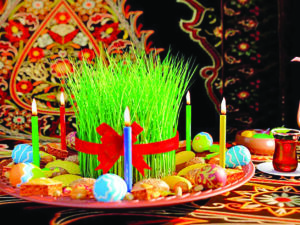 Today, Saturday 30th March, 2024, is the Saturday between Good Friday (when Jesus Christ was crucified) and Easter Sunday (when Jesus Christ was resurrected), more commonly known as ‘Holy Saturday’ or Easter Eve. Today is the last day of Lent and the last day of Holy Week – the week in which Christians prepare for Easter. ‘Holy Saturday’ commemorates the one full day that Jesus Christ’s body remained in the tomb. Easter will be celebrated on March 31st, 2024.
Today, Saturday 30th March, 2024, is the Saturday between Good Friday (when Jesus Christ was crucified) and Easter Sunday (when Jesus Christ was resurrected), more commonly known as ‘Holy Saturday’ or Easter Eve. Today is the last day of Lent and the last day of Holy Week – the week in which Christians prepare for Easter. ‘Holy Saturday’ commemorates the one full day that Jesus Christ’s body remained in the tomb. Easter will be celebrated on March 31st, 2024.
Easter Follows Spring Equinox
On the heels of the spring festival of Navroze – celebrated around 21st March, comes Easter, yet again to celebrate hope and new life – with eggs, bread and fire in common! Many also decorate the Easter table just the way Zoroastrians set the Meiz-e-Murad (table of good wishes) at Navroze. Items on the Easter table include depictions of the resurrection of Jesus Christ, painted eggs, hot-cross buns, flowers, and other food items. There would also be the adorable Easter Bunny. Scholars believe that the Easter Bunny originated in pre-Christian Germany where the hare was believed to be the symbol of the pagan goddess, Eostre. Some scholars also believe that the feast of Easter is named after the Anglo-Saxon goddess, Eostre, celebrated as the fertility goddess and the goddess of dawn and light, during the pre-Christian era.
More importantly, Easter Sunday always occurs on the first Sunday after the Paschal Full Moon or the first Sunday following the full Moon that occurs on or after the March or the Spring Equinox which Zoroastrians and all Iranians celebrate with much gusto. While Christmas is fixed to a solar calendar and near the winter solstice (Persian feast of Yalda), Easter is based on the lunar cycles of the Jewish calendar. In the Christian tradition, the Last Supper (the final meal Jesus shared with his apostles before his crucifixion) was a Passover feast. It is because Easter is based on a lunar month of twenty-nine and a half day that the date of Easter can vary.
It is important to note that the spring equinox date used by the Christian Roman Catholic Church is always March 21. In fact, the astronomical date of the equinox can shift by a day or so. For example, this year, the astronomical date of the equinox was not 21st March and yet 21st March 2024 was considered as the ‘ecclesiastical equinox’ (i.e., the date used by the Church).

Easter Eggs And Buns
Like Navroze, Easter is a spring festival and celebrated with eggs and bread (Persian noon). While the people of Iran place brightly painted eggs and flat bread on the Navroze table as a symbol of new life, vitality and fertility, Christians view the egg as a symbol of the Resurrection, and bread as the spiritual strength giving body of Jesus. Just as Jesus rose from the tomb, the egg symbolizes new life emerging from the eggshell. In the Orthodox tradition, eggs are painted red to symbolize the blood that Jesus shed on the cross.
In the Christian tradition, the making of buns with a cross on them and consuming them after breaking the fast on Good Friday, along with crying out ‘Hot Cross Buns’, is done to commemorate the crucifixion of Jesus. It is believed that the contemporary hot cross bun of Christianity originates from St. Albans in England, where in 1361, Brother Thomas Rodcliffe, a 14th century Christian monk at St. Albans Abbey, developed a similar recipe, called ‘Alban Bun’, and distributed the bun to the poor on Good Friday.
The day before his crucifixion, Jesus observed Passover with his disciples. This event is known as the Last Supper. Passover is the time that Jews remember their freedom from slavery and exodus from Egypt. During this Passover feast, Jesus told his disciples that the bread symbolizes his body that would be broken and the wine, his blood, which would be poured out for the forgiveness of sins (Matthew 26:17-30). The Last Supper is remembered today in churches and religious services through the act of taking Communion and sharing bread and wine to remember the sacrifice of Jesus.
Jesus was arrested by Roman soldiers after the Passover meal while he was praying in the Garden of Gethsemane. He was then taken before the Roman Governor, Pontius Pilate, for trial. He was ultimately crucified on a cross.
In ancient times crucifixion was considered one of the most brutal and shameful modes of death. Probably originating with the Assyrians and Babylonians, it was also used systematically by the Persians in the 6th century BC. Alexander the Great brought it from Persia to the eastern Mediterranean countries in the 4th century BC, and the Phoenicians introduced it to Rome in the 3rd century BC. The Romans perfected the mode of crucifixion for over five hundred years until it was abolished by Emperor Constantine I in the 4th century AD. Crucifixion in Roman times was applied mostly to slaves, disgraced soldiers, Christians, foreigners and only very rarely to Roman citizens.
Holy Fire At Jerusalem
In Christianity, there is the tradition of the Holy Fire at the ‘Church of the Holy Sepulcher’ (aka ‘Holy Sepulcher’) – a church built at the traditional site of Jesus’ Crucifixion and burial, in Jerusalem. According to the Bible (John 19:41–42), the tomb of Jesus was close to the place of the crucifixion, and so the church was planned to enclose the site of both – the cross and the tomb.
The Holy Fire (or ‘Holy Light’ as recognized by the Eastern Orthodox Church) is described by Orthodox Christians as a miracle that occurs every year at the Church of the Holy Sepulcher in Jerusalem on Great Saturday (which happens to be today), or Holy Saturday, the day preceding Orthodox Easter.
There is a belief that the Holy Fire rekindles annually on the day preceding Orthodox Pascha (Orthodox Easter). At this time, blue light is said to emit within Jesus’ tomb, rising from the marble slab covering the stone bed, believed to be the stone upon which Jesus’ body was placed for burial. The light is believed to form a column of fire, from which candles are lit. This fire is then used to light the candles of the clergy and pilgrims in attendance. The fire is also said to spontaneously light other lamps and candles around the church. Pilgrims and clergy say that the Holy Fire does not burn them.
Thousands of pilgrims as well as local Christians of all denominations gather in Jerusalem to partake and witness this annual event. Even for rationalists who think and believe that what happens every year at Jerusalem is not a ‘miracle’, what is significant to note is the symbolic depiction of the rising of the Son of God (Jesus) in the form of light and fire.
- The Poison of Pessimism - 27 April2024
- Celebrating The Interplay Of Life And Fire! - 20 April2024
- Customs To Observe At Atash Behram Or Agyari - 13 April2024
